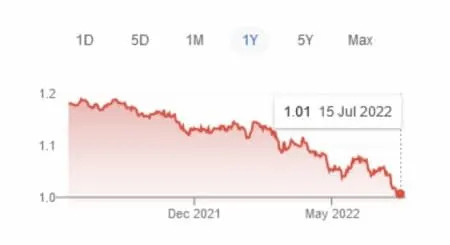By OilPrice.com – A few days ago, a rare event in the forex markets took place: for the first time in two decades, the euro achieved parity with the U.S. dollar. The euro’s epic collapse has seen it weaken nearly 12% YTD against the greenback, putting it on course for one of the worst years in its 23-year history as Russia’s war on Ukraine exacerbates the biggest global energy crisis in modern times.
The euro is currently quoted at $1.01. The last time the euro–the world’s second most popular reserve currency after the dollar–dropped to these levels was in 2015 after the European Central Bank unleashed a massive stimulus. But analysts are warning it could get much worse for the euro, with further disruptions to the continent’s natural gas supplies likely to send it as low as $0.90.
Sadly for the euro, it’s unfriendly Russia which holds its fate in its hands at this juncture.
The euro’s latest drubbing came after gas flows through Russia’s Nordstream 1 pipeline shut for 10 days for maintenance, cutting off the flow of natural gas from Russia to Germany and other EU nations. However, there are fears that if Moscow decides to extend the shutdown, it will force Germany — already in stage two of a three-tier emergency gas plan — to ration fuel and put more pressure on the euro. JPMorgan considers a complete stoppage of Russian gas flows to Germany as the worst-case scenario–in which case the euro could crash to $0.90.
“If the gas pipeline that’s closed for 10 days doesn’t reopen and we get more gas rationing, in that situation we may not have seen the weakest levels of the euro,” Christian Keller, head of economics research at Barclays, has told Reuters.
Euro/USD

Spiraling Energy Costs
Spiraling energy costs are already exerting a heavy toll on European economies. Germany, the region’s leading economy, has just reported its first trade deficit since 1991, with investor sentiment returning to pandemic lows.
According to BNP Paribas the euro tends to suffer more than other developed currencies in times of energy crises, falling an average of 4.5% during such times. This suggests the ongoing energy shocks are much worse than historical averages.
To be fair, technical factors and options markets are probably playing a big part in dictating the euro’s short-term trajectory. Currently, Reuters has reported that options to the tune of $1 billion to $1.5 billion expire next week, and there are growing fears that sustained parity with the dollar will trigger orders to sell more euros, potentially sending it to $0.95.
But this has largely got to do with spiraling energy prices coupled with runaway inflation.
To wit, Citi analysts have predicted that a Russian supply halt will send gas prices surging well above current levels of around 170 euros per megawatt hour. The analysts see the euro falling to $0.98 if gas hits 200 euros and $0.95 if gas prices rocket to 250 euros.
And, don’t expect the ECB to come to the euro’s rescue this time around.
In theory, the ECB could ease some of the selling pressure on the euro by selling dollars to prop up the currency as it did back in 2000 when the euro crashed to $0.83. However, it has already signaled an unwillingness to directly intervene, possibly due to the fact that the euro’s “real” exchange rate is still well above where it sat the last time euro-dollar parity was hit in 2002.
Luckily, Europe might just be able to avoid a complete meltdown thanks to falling oil prices.
Over the past couple of weeks, the oil price rally has cooled off considerably, with crude currently hovering at $100/bbl from recent highs of $120/bbl largely on fears of a global economic slowdown.
Also weighing on the markets are fears of further demand destruction after Shanghai and some other Chinese cities started enacting fresh COVID-19 restrictions ranging from business shutdowns to broader lockdowns in an effort to control the spread of the latest Covid-19 variant.
The latest selloff has extended the energy sector’s losing streak and plunged it into bear territory for the first time in months. It has also reversed a recent trend where the sector was outperforming all other 10 market sectors to a situation where it’s underperforming virtually everything. The selloff has been so deep that prices have crashed all the way along the futures curve. For instance, Brent for December 2023 shed 8.8% on Tuesday to trade at its lowest level since March, almost as much as nearby prices. Market experts have also interpreted the slide as a sign that some oil producers have been selling longer-dated contracts to hedge their supplies. Although such volumes have so far been rather modest, they can still compound the pressure on nearby futures.
A brawny dollar has also not been helping oil and commodity prices as the leading currency continues to be the world’s preferred safe haven during these turbulent times.
“Capital flooding into U.S. dollars, which has sent [the dollar] soaring… appears to be putting a headwind in front of commodity prices,” Colin Cieszynski, chief market strategist at SIA Wealth Management, has told MarketWatch.
The bad news for the oil bulls is that there’s little reprieve on the horizon, with the latest data showing that inflation in the United States hit a torrid 9.1% clip in June, the highest reading since 1981, once again exceeding expectations and raising the odds the Fed will continue its aggressive rate-hike regime.
But this might be good news for Europe’s economy, with high energy prices largely to blame for the poor state of the economy. Indeed, the Conference Board has predicted that “GDP in the Euro Area will most likely continue to expand in the second half of 2022 and in 2023 escaping a recession despite the headwinds generated by the Russian invasion of Ukraine.”
By Alex Kimani for Oilprice.com



